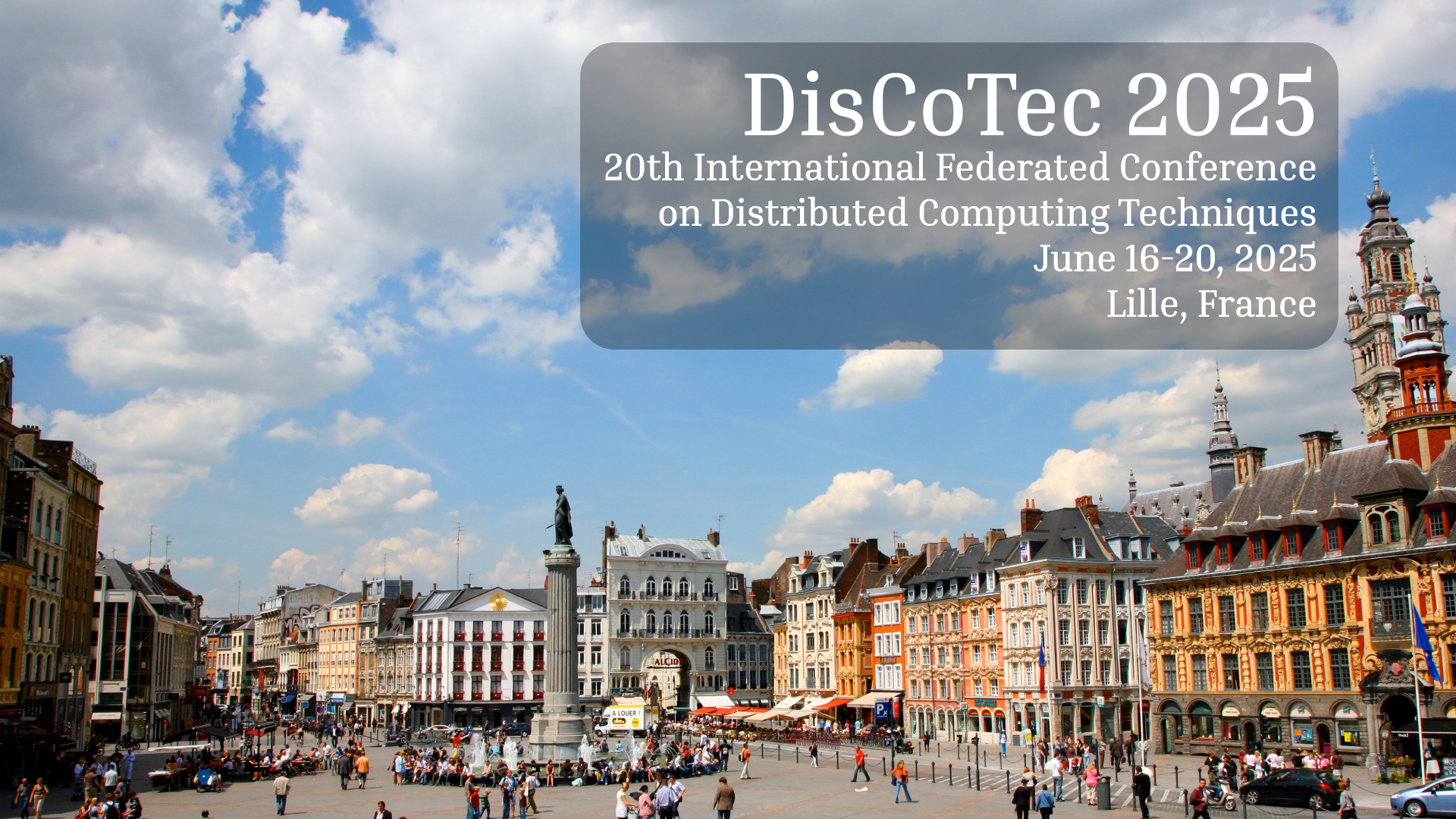COORDINATION
1
Authors: Christopher Esterhuyse, Benjamin Lion, Hans-Dieter Hiep and Farhad Arbab.
Title: Formal Foundations for Reowolf: Multi-Party Sessions via Synchronous Protocol Programming
Abstract: The Reowolf project developed connectors as a replacement of two-party network sockets for multi-party communication in next-generation internet applications. Users control connectors via protocols in the bespoke protocol description language (PDL), which is based on synchronous languages such as Reo and Esterel. The novelty lies in the emphasis on dynamism: users refine protocols throughout their execution. Weformalisethesemanticsof PDL,distinguishingdual notionsof protocol behaviour: accepted behaviour is highly (de)compositional and specifies what communication is allowed, while constructed behaviour arises from protocol execution and accounts for how execution steps interdepend and interleave via messages sent and received. Toward machine-checking the correctness of the connector runtime reference implementation, we specify the API and correctness criteria of PDL runtime systems.
pdf: pdf
2
Authors: Alessandro Aldini and Claudio Antares Mezzina.
Title:Formalizing Errors in CCS with 3-Valued Logic
Abstract: Concurrent and distributed systems are often prone to failures. Errors in modeling an agent’s behavior can propagate into large interacting systems with unexpected consequences. In this paper, we propose a theory for the process algebra CCS enriched with a formal and explicit representation of errors based on McCarthy’s style three-valued logic, which includes the traditional Boolean values and a third error value. In this setting, we formally study how the emergence of local errors may or may not result in propagation, as also emphasized in a real-world case study modeling a distributed microservices architecture.
pdf: pdf
3
Authors: Robert Rubbens, Petra van den Bos and Marieke Huisman.
Title: Verified Parameterized Choreographies
Abstract: Choreographies are useful for modelling systems with multiple simultaneously executing and communicating participants, e.g. distributed systems. VeyMont can verify correctness of choreographies and generate verifiably correct code that implements the choreography. Initially, it supported only fixed sets of participants. However, realistic systems are often parameterized: they scale according to some parameter N . This paper extends VeyMont with parameterized choreographies, making VeyMont more usable for realistic case studies. Specifically, we add parameterized primitives such as participant families and parameterized communication. We encode these primitives using a structured parallelism primitive from the underlying verifier VerCors, and by using conditionals in the endpoint projection, partially delaying projection until run time. We illustrate the encoding with a distributed summation choreography, and prove it correct with VerCors.
pdf: pdf
4
Authors: Fabio Gadducci, Carlos Olarte and Frank Valencia.
Title: A Constraint Opinion Model
Abstract: This paper introduces a generalized opinion model that extends the standard DeGroot model by representing agents’ opinions and influences as soft constraints rather than single real values. This allows for modeling scenarios beyond the scope of the DeGroot model, such as agents sharing partial information and preferences, engaging in discussions on multiple topics simultaneously, and representing opinions with different degrees of uncertainty. By considering soft constraints as influences, the proposed model captures also situations where agents impose conditions on how others’ opinions are integrated during belief revision. Finally, the flexibility offered by soft constraints allows us to introduce a novel polarization measure that takes advantage of this generalized framework.
pdf: pdf
5
Authors: Nikolaus Huber, Susanne Graf, Philipp Rümmer and Wang Yi.
Title: MIMOSA: A Language for Asynchronous Implementation of Embedded Systems Software
Abstract: This paper introduces the Mimosa language, a programming language for the design and implementation of asynchronous reactive systems, describing them as a collection of time-triggered processes which communicate through FIFO buffers. Syntactically, Mimosa builds upon the Lustre data-flow language, augmenting it with a new semantics to allow for the expression of side-effectful computations, and extending it with an asynchronous coordination layer which orchestrates the communication between processes. A formal semantics is given to both the process and coordination layer through a textual and graphical rewriting calculus, respectively, and a prototype interpreter for simulation is provided.
pdf: pdf
6
Authors: Antonio Brogi, Roberto Casadei, Nicolas Farabegoli, Stefano Forti and Mirko Viroli.
Title: Declarative Deployment Planning for Green Pulverised Collective Computational Systems
Abstract: To promote non-functional goals (e.g., energy efficiency and reactivity) in system implementations, multiple strategies can be adopted, including the partitioning of distributed applications and the smart deployment of the resulting sub-components across the edge-cloud continuum. Within the aggregate computing approach to collective adaptive systems engineering (e.g., IoT ecosystems and robot swarms), the pulverisation model of partitioning and deployment works by splitting the collective computation into device computation rounds and in turn the device com- putation round in terms of five components: sensing, actuation, behaviour, state, and communication components. Previous research has investigated how different deployments of pulverised systems can provide different trade-offs involving performance and efficiency, with methodologies and simulation tools to carry out the comparison. However, there is still no contribution about the generation or search of effective deployments in the first place. To address this gap, this work introduces Declarative Deployment Planning for Pulverised Systems (DePPS), an approach and toolchain based on simulation and a Prolog-based planner to guide the search of candidate deployments of pulverised systems. The benefits of the approach lie in its declarativity, modularity, scalability, and amenability for continuous reasoning of deployment alternatives. We exercise the approach with synthetic experiments and find out that we can achieve “greener” deployments (i.e., with low energy consumption and carbon footprint) while preserving good latencies compared to uniform peer-to-peer deployments.
pdf: pdf
7
Authors: Giorgio Delzanno, Cosimo Laneve, Arnaud Sangnier and Gianluigi Zavattaro.
Title: Decidability Problems for Micro-Stipula
Abstract: Micro-Stipula is a stateful calculus in which clauses can be activated either through interactions with the external environment or by the evaluation of time expressions. Despite the apparent simplicity of its syntax and operational model, the combination of state evolution, time reasoning, and nondeterminism gives rise to significant analytical challenges. In particular, we show that determining whether a clause is never executed is undecidable. We formally prove that this undecidability result holds even for syntactically restricted fragments: namely, the time-ahead fragment, where all time expressions are strictly positive, and the instantaneous fragment, where all time expressions evaluate to zero. On the other hand, we identify a decidable subfragment: within the instantaneous fragment, reachability becomes decidable when the initial states of functions and events are disjoint.
pdf: pdf
8
Authors: Carlos Gustavo Lopez Pombo, Agustín Eloy Martinez-Suñé, Hernan Melgratti, Diego Senarruzza Anabia and Emilio Tuosto.
Title: Behavioural, Functional, and Non-Functional Contracts for Dynamic Selection of Services
Abstract: We propose a mechanism for selecting distributed services which encompasses three orthogonal, yet related type of contracts’ compliance. Indeed, we envisage contract compliance as the intersection of behavioural contract compliance with the compliance of functional and non-functional contracts. We model services as communicating-finite state machines (CFSMs) suitably extended to capture data-awareness and application-level quality-of-service (QoS). This extension is instrumental to define our notion of contract compliance in terms of a bisimulation relation for this new class of CFSMs. More precisely, we introduce CFSMs where transitions are decorated with constraints on the payloads while states of CFSMs have decorations that carry QoS contracts. This allows us to capture behavioural contracts (considering the communication pattern as usual in systems of CFSMs) as well as functional and non-functional contracts. We use a case study to assess our approach and we discuss tool support for our framework.
pdf: pdf
9
Author: Carolyn Talcott.
Title:Dialects for the CoAP IoT Messaging Protocol
Abstract: Messaging protocols for resource limited systems such as distributed IoT systems are often vulnerable to attacks due to security choices made to conserve resources such as time, memory, or bandwidth. Protocol dialects are a light weight, modular mechanism to provide security guarantees such as authentication or integrity. In this paper we propose a generic dialect for the Constrained Application Protocol (CoAP) messaging protocol. The CoAP protocol, dialect, and an attack models are formalized in the rewriting logic system Maude. A number of properties relating CoAP and its dialected form are given, including a stuttering bisimulation, thus ensuring that dialecting preserves important properties of a CoAP application. The ideas are illustrated with some simple scenarios.
pdf: pdf
10
Authors: Tilman Zuckmantel, Thomas Hildebrandt, Yongluan Zhou and Boris Düdder.
Title: DACEO: Declarative Asynchronous Choreographies with Data-dependent Event Ordering
Abstract: We provide a formal modeling language, DACEO, for declarative asynchronous choreographies with general data-dependent message ordering and data objects. The language is equipped with execution semantics, and thereby, it can be used to specify the semantic and support monitoring of asynchronous distributed event-based systems in which a total ordering of message delivery cannot be assumed. DACEO models are graphs, which extends previous work on synchronous declarative choreographies based on Dynamic Condition Response Graphs and their operational semantics by adding asynchronous message channels with general data-dependent ordering constraints as well as general objects and data activities. The addition of objects builds on recent work on object-centric Dynamic Condition Response Graphs. We show that the DACEO Graphs can be encoded as the more basic Synchronous Object-centric Dynamic Condition Response Choreographies, preserving the se- mantics. We motivate DACEO by demonstrating its applicability in describing data-dependent ordering constraints between messages using a running example that shows how a system with causal consistency requirements can be specified. The marketplace is built on a benchmark for microservices that relies on asynchronous, event-based communication.
pdf: pdf
11
Authors: José Proença and Maurice H. ter Beek.
Title: RebeCaos
Abstract: We describe RebeCaos, a user-friendly web-based front-end tool for the Rebeca language, based on the Caos library for Scala. RebeCaos can simulate different operational semantics of (timed) Rebeca, thus facilitatingthedisseminationandawarenessof Rebeca,providinginsights into the differences among existing semantics for Rebeca, and supporting quick experimentation of new Rebeca variants (e.g., when the order of received messages is preserved). The tool also comes with initial reachability analyses for Rebeca models (e.g., the possibility of reaching dead- locks or desirable states). We illustrate the RebeCaos tool by means of a ticket service use case from the timed Rebeca literature.
pdf: pdf
12
Authors: Gianluca Aguzzi, Lorenzo Bacchini, Martina Baiardi, Roberto Casadei, Angela Cortecchia, Davide Domini, Nicolas Farabegoli, Danilo Pianini and Mirko Viroli.
Title: A Demonstrator Toolchain for Self-organizing Robot Teams
Abstract: Aggregate computing is a paradigm with over a decade of investigation and multiple programming frameworks available, which proved to be particularly suitable for the simulation of applications in challenging domains such as smart cities and robot swarms. This paper introduces a toolchain for practical multi-robot demonstrations based on aggregate computing principles, and validates it with a live interactive demo in an open-public event in the context of the European Researchers’ Night. More specifically, we show how we coordinated a team of mobile robots to form spatial patterns. We discuss the practical demonstration performed in an indoor environment, which exploits a camera system and ArUco markers for localization.
pdf: pdf






